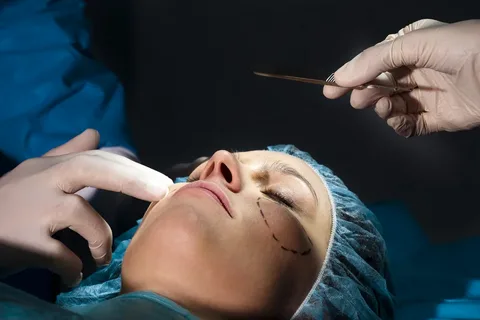For the transgender woman who wishes to feminize her face and create a more youthful appearance, but feels bony re-contouring of the forehead and jaw is too extensive of an approach, may wish to consider a minimally invasive facelift and feminization.
For almost a decade many people have successfully undergone minimally invasive surgery to improve the look of their forehead without visible scars. Minimally invasive brow lifts provided several other advantages too, including reduced swelling and bruising, and quicker recovery – without the raised hairline of traditional brow lifts. The surgeon doesn’t invade the body with a large incision, but operates through very small incisions with use of special cameras and instruments. This method has proved to be an excellent and widely accepted addition to the many techniques of cosmetic surgery.
Minimally Invasive Surgery
The technology that allows minimally invasive facelifts is increasingly being used in many areas of surgery. You may have heard of it referred to as endoscopic surgery. In abdominal surgery it’s called laparoscopy or “belly-button surgery.” In some uses it is called arthroscopy. It employs the endoscope (or “scope”), a tube-like instrument that is inserted under the skin in order to see and operate on different parts of the body. You’re probably familiar with its use in surgery of the knee, gall bladder and many other parts of the body. This minimally invasive surgery takes advantage of a number of new developments in miniaturization of cameras, lighting, and delicate instruments. The surgeon can see and control everything because the camera transmits the image with a high degree of magnification to a video monitor. All the surgically important tissues of the body are visible – even tiny blood vessels and nerves.
Minimally invasive surgery is especially appropriate for cosmetic surgery –after all, you don’t want to wind up with scars that detract from the “new you.” Many transgender women have minimal brow ridges and simply don’t consider a scar running in front of the length of their hairline to be an acceptable compromise. You want as little scarring as possible from any surgery, of course, but particularly from aesthetic procedures. Many aesthetic surgeons offer to do endoscopic brow surgery. Endoscopic surgery of the whole face has even more merit. Where else than the most visible part of the body is it so important to minimize scarring and return you to public life sooner?
The endoscopic brow lift avoids the major scarring, hair loss, sensory loss, and numbness common to traditional brow lifts. And, whereas the traditional lift often resulted in the hairline being raised up as much as an inch, the minimally invasive approach produces virtually no raising of the hairline.
Individualized Facial Surgery
Different regions or zones of your face may age at different rates, and may require less (or no) feminizing surgery. Attempting to redo the entire face may be unnecessary and may create disharmony when repair of the most minor deviation from the female facial ideal is attempted. Aesthetic surgeons should concentrate on the facial areas where the most aging and masculinizing effects appear and try to establish a harmonious facial look. Attempting to reconstruct the face as a whole might not achieve this ideal. Facial harmony may be lost because of the nature of regional aging, very minimal and localized masculinization, or because of limitations of a previous cosmetic surgery.
Minimally invasive surgery – or endoscopic surgery – of the face produces a very natural look and is suitable for most people. The endoscopic approach can lift the eyelids. and can lift and tighten at the mid-face level, where the fat pads of the cheeks commonly need elevation for a more feminine look. And it can lift the sagging jawline. This new surgery is especially appropriate in undoing the unflattering or unnatural look in some people who have undergone previous facial recontouring or facial face lifts.
The Incisions
That “wind tunnel” look of some traditional face lifts of the mid-face region is the result of the nature of the incisions. The traditional incision essentially goes vertically in front of the ear and into the temple. Because the pulling and tightening of the skin is performed perpendicular to an incision, the tissue in this case is pulled in a horizontal direction. A face lift performed in this traditional method may eventually tend to produce unnatural creases and folds that become even more pronounced when the patient’s face is animated, such as in conversation. The result unfortunately may be abnormal-looking creases or wrinkles from the corner of the mouth to the ears. This “swept back” look is usually a dead give-away that the person has had a face lift. Unfortunately, if you have developed this look as the result of a traditional face lift, additional face lifts by the same method will almost always just make it worse.
By contrast, endoscopic face lifts use three to five half-inch incisions behind the hairline at the forehead and temples. The pulling direction is more upward, and the result is to bring the tissues into the more natural position of your youth. Think of it like this: When your facial tissues go south, you want this corrected by taking them back northward, not east and west!
Endoscopic surgery can help the area around the eyes, called the periorbital region. The sad-eyed look may be evident even in people who have had previous eye lift surgery (or blephroplasty), because some older surgical techniques often resulted in the removal of too much fat from the lids. Minimally invasive surgery can help most of these patients. (Perhaps a “skin shortening” procedure such as a chemical peel might be of additional help, or be yet another alternative.) Only if someone has an excessive amount of skin will an excision be necessary. In most cases, a conservative amount of fatty tissue in the periorbital region is removed and the lower lid is tightened to produce that more youthful effect of a shorter distance from the lower eyelash to the bony orbital rim below the eye.
Layers of Facial Tissue
One reason endoscopic face lifts produce such a wonderful appearance is that the instruments are not tunneled just under the skin, but deeper, in what’s called the superficial facial fascia. Fascia is the very thin sheath of tissue that helps band together various muscles. At this level, the surgeon uses endoscopic tools to lift more of the foundation of the face. This way, the skin alone is not being pulled like tightening a drum. This level is important because it contains fewer blood vessels and lymph tissues and therefore is a major reason for the reduced bruising and swelling of endoscopic face lifts.
Tissue Glue
FDA approved use of a material which serves as a tissue glue in surgical practice. This gives an even bigger boost to face lift surgery and is a natural addition to the minimally invasive approach. Tissue glue is a spray-on material that augments or in some cases replaces the little stitches that surgeons use to hold facial tissues in place after they have been repositioned. This remarkable adhesive, already proved safe and effective in thousands of skin grafting operations, has for years been used in face-lift surgery in some other countries for years. It has now been brought into use in endoscopic surgery and it’s available in the U.S. With the endoscopic tools, the surgeon performing a face lift sprays the glue on a layer of tissue that’s been lifted off its foundation. That layer is repositioned to the desired point, and pressure is applied from the outside for three to five minutes while the glue “sets.” Less suturing is required, and often compression bandages on the facelift are not needed. The tissues naturally heal where they have been repositioned, and the glue is naturally eliminated.
The Endoscopic Edge
Minimally invasive techniques produce face lifts that are scarless, more natural-looking, and have quicker recovery. This method has fewer side effects than the traditional method. (For example, blood clots – or hematomas – from broken vessels can result in 5 percent of traditional face lifts but are virtually nonexistent with the endoscopic method.) Most individuals would be considered a candidate for minimally invasive surgery, but the specific approach would be customized for the individual during a facial evaluation by your chosen surgeon.
If you are considering surgery, keep in mind that a second (or third) surgical opinion increases your odds in choosing the right surgeon and the right technique.
Source: Transgender Care
 Lesbian, Gay, Bisexual, Transgender & Intersex News Lesbian News, Gay News, Bisexual News, Transgender News, Intersex News, LGBTI News
Lesbian, Gay, Bisexual, Transgender & Intersex News Lesbian News, Gay News, Bisexual News, Transgender News, Intersex News, LGBTI News




